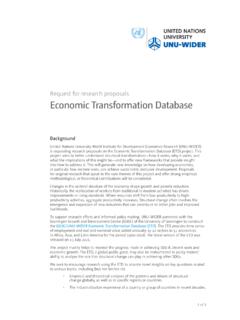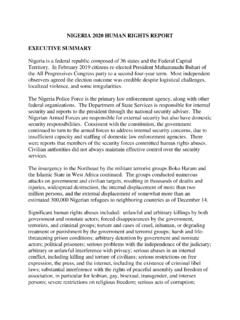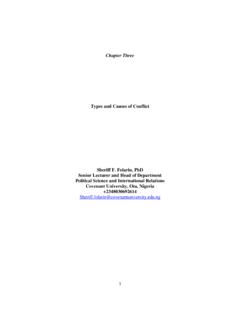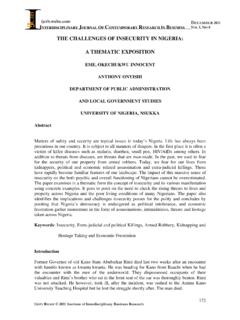Transcription of CHALLENGES AND SOLUTIONS TO MIGRANT INTEGRATION, …
1 1 CHALLENGES AND SOLUTIONS TO MIGRANT INTEGRATION, DIVERSITY AND SOCIAL COHESION IN AFRICA Dr. Linda Adhiambo. Oucho Director, Research and Data Hub African Migration and Development Policy Centre Mr. Donald Adesubomi Williams Project Officer African Migration and Development Policy Centre (AMADPOC) 2 EXTENDED ABSTRACT Migration is the movement of people from their original habitat to a destination outside the borders of their origin, purposely to settle and can be voluntary or forced. The consequences of migration are usually not predetermined, due to various stages of uncertainty that may arise, to deter the motive of the MIGRANT to relocate. The present state of migration debates is challenging the academic, humanitarian, development and government actors to look at migration differently given that the rhetoric of migration is changing.
2 Migrants are being viewed through a negative lens instead of agents of development to their country of origin or their host country. The historical events since colonialism has challenged discussions related to nationalism, and shaped national and regional policies related to migration. When a host community receives forced migrants (asylum seekers and refugees), they are unprepared to accommodate new entrants, due to the protection of limited shared resources within their territory, such as land, water, housing facilities, natural and mineral resources. Migrants are often faced with CHALLENGES of being accepted by host communities, hence the difficulties in communal integration, harmonious living, commerce, cultural practices, religious beliefs, language barriers, agricultural practices, economic activities, social integration, pastoralism and others.
3 Invariably, conflict between host communities and migrants distorts social cohesion and other forms of societal decadence. The border demarcation of Africa in 1885 by colonial powers, was a catalyst to establishing the sources of recent border conflicts that distort social cohesion, thereby resulting in xenophobia and intolerance between the host communities and the migrants. For instance, the conflict along the border of Rwanda and Democratic Republic of Congo began as an institutional obstruction of Belgian King Leopold who ruled Congo, during the colonial era, to strategically detach resource rich regions and lucrative landscapes (The Nile, Volcanoes and River Rusizi) from Rwanda and handed them over to the colonial administration of Democratic Republic of Congo.
4 The handing over of the resource rich region to Congo ensured that while the Rwandese migrants are part of the Congo border community, their status will remain as migrants and not indigenes of Congo, hence as Rwandese migrants, who by the design of the colonial powers reside in a neighbouring country, cannot own land and have no claims to the natural or mineral resources within their former territory. The ethnic identity of the Rwandese migrants is questioned by the Congolese, whenever there is dispute over land utility and ownership, which led to several armed conflicts and inability to sustain social integration with the Congolese. The province of Bufumbira was also cut out of Rwanda and handed over to Uganda, during the colonial era but the Ugandan communities have had successful relations with the Rwandese migrants and have been socially integrated into the Ugandan societies.
5 Refugees from war torn nations in East and Central Africa, residing in Uganda have been warmly accepted by the host communities as well as the Uganda government, which established a sustainable integration program for the refugees by issuing land to refugee families for farming. This integration plans have resorted to peaceful integration between the migrants and the host communities, as well as generated economic opportunities for the migrants, whereby, they can produce crops and trade them within the local markets. 3 In other cases, migrants contribute significantly to Regional Economic Integration, whereby the migrants are the agents of economic diversity through cross-border trade activities. There are also positive benefits of hosting migrants.
6 Cross-border trade contributes to the Gross Domestic Product of the host state, as well as improve the social and cultural relations between the migrants and the hosts. Cross border trade is more pronounced in the West African region, especially between Nigeria, whose population is above one hundred and seventy million. The countries that border Nigeria rely heavily on cross border trade between their countries and nigerian border communities. However, the social and economic benefits accrued are at par with emerging security threats along border communities, such as human trafficking, smuggling of contraband, proliferation of small arms and light weapons and narcotic trafficking. It is widely argued, criminal organizations operating in the region are mostly residing in border communities, where mobility is not a hindrance to their escape when they operate between two countries.
7 Crime along border communities such as Badagry, which borders Republic of Benin and Nigeria has created resentment between members of the community and the migrants who are engaged in crime. It is widely argued that when states cooperate economically, they are less likely to be conflict, suggesting that migrants are Ambassadors of peace, contributing to the good neighbourliness and strengthening regional integration. The trade integration objective of the East African Community (EAC) has spurred economic migrants within the region, which has given the leeway for the migrants to extend their businesses across borders, thereby creating new jobs for host communities as well as improved social cohesion between the migrants and their hosts.
8 The underlining motive behind economic integration is to develop the atmosphere for countries to integrate markets as well as improve socio-cultural relationships. Both agendas are conducted by migrants. Nevertheless, forced migrants may be unable to contribute in equal measure as voluntary migrants within the host community, due to the psychological effect of war on their productive capacities but also their lack of access to resources within the host country. Both voluntary and forced migrants contribute to the cultural diversity of host communities through social interaction, which may be accepted or repelled. Hence, their relations could be a catalyst for development or conflict.
9 Intra-cultural relations may result in racist or xenophobic attacks, especially when opposing ideologies are consistent in the lifestyle of the migrants who are of a different race, as witnessed between Somali migrants hosted in different countries across the globe. In the case where both MIGRANT and hosts are of similar race, the resentments would qualify as xenophobic. South Africa is an example of a state that experiences xenophobia and racism concurrently. The white and black race in South Africa are constantly conflicting over economic resources, while the black race of South Africa is also in conflict with other African migrants, depicting xenophobia. Kenya presents a clear example of racism, xenophobia, intolerance, social cohesion, integration and diversity.
10 When Kenya began developing its railway, the Indians were contracted to build the network as well as maintain them, which meant their settlement 4 in the country. These rail workers became citizens of Kenya and has since become the largest non-African community. However, their settlement brought about racism, which is dominant in their relationship other race, till date. Kenyans have also been xenophobic with other Africans, especially the Somalis who dominate the North-Eastern part of the country. The diverse ethnic groups exhibit intolerance between them which has hindered the prospect of nationalism after its demise, after independence. Intolerance is widely displayed among in-migrants when they are either in transit or converge with other tribes in urban cities.











